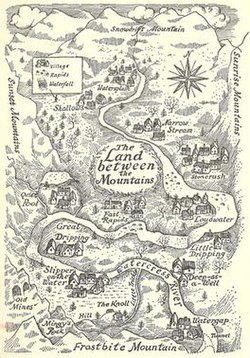Plot
Slipper-on-the-Water is home to a clan known as the Periods, who are descendants of Fooley the Magnificent or the Great Fooley, who 440 years before the book opens constructed a balloon, flew to the land beyond the mountains and returned with a case of curiosities. They hold high offices in Slipper-on-the-Water, have very high opinions of themselves and have a "Council of Periods" that rules the village. Also living in the village are a group of Minnipins referred to as "Them" by the other villagers. These include Gummy, Walter the Earl and Curley Green. "Them" shun the tradition-based existence of the other Minnipins. One night, a Minnipin named Muggles wakes up and sees fires in the Sunset Mountains in the West. While digging for treasure, Walter the Earl discovers a vault under his house and finds iron chests that contain ancient scrolls, swords, armor and military trumpets. The scrolls reveal Fooley the Magnificent's story and contain ominous warnings from Walter the Earl's forebear Walter the Obtuse saying that the vault will be found when it is needed for the protection of the Minnipins.
The mayor returns from the annual meeting of village mayors with news that there will be a contest to find the finest village in the Land Between the Mountains. The winning village will win the legendary and sacred Gammage Cup. The villagers are excited but the Periods convince the villagers that "Them" will ruin their chances of winning the cup. During a town meeting, the Periods outlaw "Them". Mingy, the curmudgeonly money-keeper who resists spending money for "fancying up the village" is also outlawed. Along with Muggles who has become involved with "Them" because of her seeing the fires on the Sunset Mountains.
The "Outlaws" paddle up the river to Gummy's stone cabin on The Knoll. They move in but the cabin is too small for all of them, so they decide to sleep outside until a new house is built. Muggles organizes their working efforts and after much progress is made, they explore the Old Mines in the Sunset Mountains. Walter the Earl brings an iron sword from the vault. Inside the mines the sword glows as a warning, and they hear tapping sounds. After this phenomenon occurs again, they assume that the legendary enemies of the Minnipins known as The Mushrooms have returned and are preparing to attack, and they hold a council of war.
Muggles decides that Mingy should reconnoiter the Old Mines while the rest of the "Outlaws" wait behind. In the mines, Mingy sees several hairless creatures with mushroom-colored skin round bellies and big ears and wearing tight, brownish-white clothes. Over 200 of them emerge from the mines. Mingy concludes that these must be the Mushrooms and tries to return to the others, but his is foot is trapped in the rocks. The rest of the Outlaws rush to save Mingy as the Mushrooms swarm to capture him. They chase most of the Mushrooms away but four of them capture Mingy and carry him into the mountain. Gummy chases them into the Old Mines and returns after he is hit by a poisonous spear.
The group return to Gummy's cabin to tend to his worsening wound. Curly Green and Muggles stay and defend Gummy while Walter the Earl returns to Slipper-on-the-Water to raise an army to fight the Mushrooms. Walter the Earl tries to tell the Periods mayor and council about the coming Mushroom army but they will not listen. He decides to raise the village without the help of the Periods. He is successful, but the Periods tell the villagers the Walter is deranged and the villagers are uncertain what to do. An eerie chanting is heard from the mountains.
In the Old Mines, the Mushroom chief refuses to kill Mingy. One of the Mushrooms is scratched by a poison spear and Mingy watches as a white substance is used on the scratch, and thinks this may help his foot. After the Mushrooms leave to fight, he puts some on his foot, which feels better. The Mushroom army attacks the cabin where Gummy, Curly Green and Muggles are hiding. Gummy becomes weak because of the poison from the spear and Curly Green is knocked out while Muggles wards off the Mushrooms. The Minnipin army attacks and a fierce battle ensues. As the Mushrooms flee back into the Old Mines, Mingy sets a heap of mats on fire, making it impossible for the Mushrooms to escape. They rush out to escape the flames and are defeated by the Minnipin army. Mingy emerges from the cave holding the pot of white substance which is used cure Gummy and the injured Minnipins soldiers.
The Period village council regrets expelling the Outlaws and no longer cares about winning the Gammage Cup. The villagers celebrate the return of the soldiers and the five Outlaws. The three judges of the contest arrive. Witnessing the happy scene, they decide that Slipper-on-the-Water is the most deserving village and leave the Gammage Cup in the town square.

